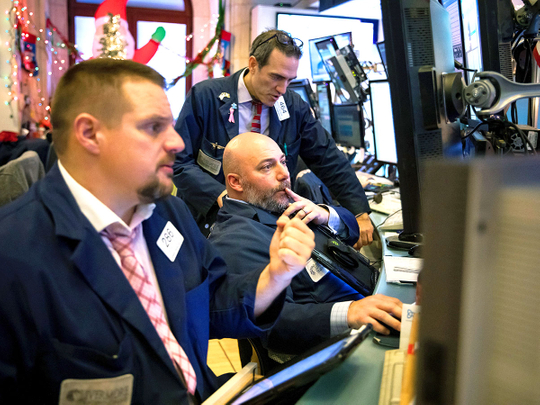
After six weeks of stomach-churning swings, a cry’s gone up from stock pickers: Make it stop.
For the group that bemoaned last year’s one-way market as impossible to trade, it’s no small irony. Life’s only gotten harder since October as the S&P 500 lurches from rally to rout at an alarming rate. So with just three weeks left in the year, many active managers are looking to make up lost ground and say they’d welcome a return of that historical calm.
“People are feeling a little demoralised right now,” said Tony Dwyer, a strategist with Canaccord Genuity. “If you have a better close to the year, some of the pain that they’re feeling now will go away obviously. It’s been a really challenging year.”
That’s because no strategy seems to work. The S&P 500 Index sank 4.6 per cent in the latest week, the biggest decline since March. In the past three weeks, US stocks have alternated between gains and losses of at least 3 per cent. Not since the height of the financial crisis a decade ago have investors been buffeted by that kind of volatility.
And the swings aren’t confined to weekly moves. Take Thursday, when the S&P 500 plunged as much as 2.9 per cent before paring losses to end the session down less than 0.2 per cent. Early gains Friday evaporated into yet another 2 per cent rout. The reasons for the violent swings are numerous but boil down to concern that rising interest rates and the ongoing trade war will throttle global growth and corporate profits.
The whipsaw is adding to stress among fund managers, who have seen their year-to-date outperformance completely wiped out since October. Through Wednesday, the group trailed the market by 84 basis points in 2018, a reversal from 2 percentage points in front earlier in the year, data compiled by Wells Fargo showed.
Stock reversals
As investors look to claw back from losses with the deadline for their annual scorecard looming, they are presented with a conundrum on timing. Valuations have fallen to levels last seen in 2016, as prices slumped while corporate profits kept growing. While profits are forecast to grow 9 per cent next year, that estimate could dwindle if the trade war continues to hamstring corporate decision-making.
“It’s really going to come down to the outcome in trade negotiations in future months and probably years, to really understand if this defensive bias is something that will persist or if we will get an opportunity to dip our toes back into some historically cheap markets,” said Andrea DiCenso, vice president and co-portfolio manager at Loomis Sayles. “Problem is, to dip your toes back in, you need momentum to be in your favour.”
It decidedly is in no one’s favour. Friday brought another round of head-spinning reversals. Stocks erased overnight losses to rise at the open on speculation the latest hiring data will give cover to a dovish Fed. Fresh concern that the Trump administration won’t ease trade tensions sent the S&P 500 careening as much as 2.7 per cent as key technical levels buckled.
This week’s sell-off is especially bad news for hedge funds that just warmed to stocks after months of playing defensive. Their gross leverage, a measure of the industry’s risk appetite, climbed 2.5 percentage points to 234.5 per cent as of November 29, from a one-year low reached 10 days earlier, client data compiled by Goldman Sachs showed. Similarly, JPMorgan’s hedge fund clients last week raised their equity exposure at one of the fastest rates this year.
The industry is heading for its worst year since 2011 as the S&P 500 has suffered two 10 per cent corrections. The Hedge Fund Research HFRX Equity Hedge Index has lost 6 per cent since January, compared with flat returns in the benchmark index.
“The growing list of market risk signals may speak to the persistence of equity market turbulence and by extension, risks to hedge fund performance,” Mark Connors, global head of risk advisory at Credit Suisse, wrote in a note to clients.












